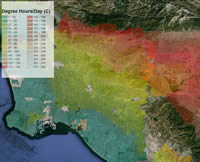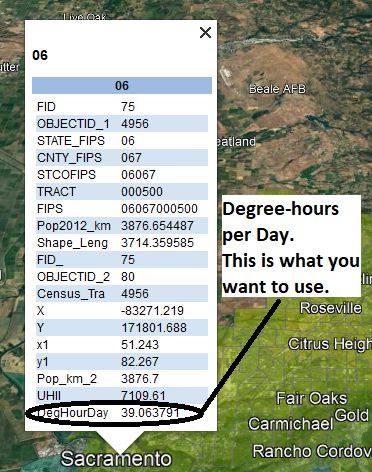This interactive map shows urban heat islands in California as measured by the Urban Heat Island Index. The urban heat islands are color coded according to their intensity, with green representing the smallest effect and red to white representing the greatest intensity. The map legend shows the range of intensity.
Downloading the Map
The map requires that you have installed the free Google Earth application.
Urban Heat Island Map (Download KMZ 15 MB)
 Once the map is open, click on urban areas to view the urban heat island effect by census tract. It will show the 15 data values about the census tract. The next-to-last row, labeled “UHII,” adds up all the temperature differences every hour for every day over two summers. To make the index more intuitive, we divide by 182 and report the result in the last row, labeled “DegHourDay.” This quantity is the heat island effect calculated in degree-hours per day (Celsius).
Once the map is open, click on urban areas to view the urban heat island effect by census tract. It will show the 15 data values about the census tract. The next-to-last row, labeled “UHII,” adds up all the temperature differences every hour for every day over two summers. To make the index more intuitive, we divide by 182 and report the result in the last row, labeled “DegHourDay.” This quantity is the heat island effect calculated in degree-hours per day (Celsius).
Individual Maps and Data Files
Download All Data File – maps, census tracts, centroids, shapefiles and other GIS files (Zip File, 254.6 MB)
Download Census tract locations (latlon) and UHII (Excel File, 1.0 MB)
How the Index is Calculated
The UHII is calculated by atmospheric modeling, as a temperature differential over time between an urban census tract and nearby upwind rural reference points at a height of two meters above ground level, where people experience heat. The modeling covered 182 warm season days from 2006 and 2013, with one-hour timesteps, so the UHII is the sum of 24 * 182 = 4,368 hourly temperature differences.
 Since 2020, the index is also reported in degree-hours per day on a Celsius scale – a measure of heat intensity over time, calculated by dividing the UHII by 182 days. An increase of one degree over an eight hour period would equal eight degree-hours, as would an increase of two degrees over a four-hour period. The interactive map also shows this version of the index, on the bottom row, labeled “DegHourDay” when you click on a census tract.
Since 2020, the index is also reported in degree-hours per day on a Celsius scale – a measure of heat intensity over time, calculated by dividing the UHII by 182 days. An increase of one degree over an eight hour period would equal eight degree-hours, as would an increase of two degrees over a four-hour period. The interactive map also shows this version of the index, on the bottom row, labeled “DegHourDay” when you click on a census tract.
If you are using GIS software and reading in the GIS files, you will not find DegHourDay as a field, but you can easily calculate it:
DegHourDay = UHII / 182.
Office of the Secretary
California Environmental Protection Agency
1001 I Street
P.O. Box 2815
Sacramento, Ca 95812
Climate Change Advisor
(916) 445-0039

